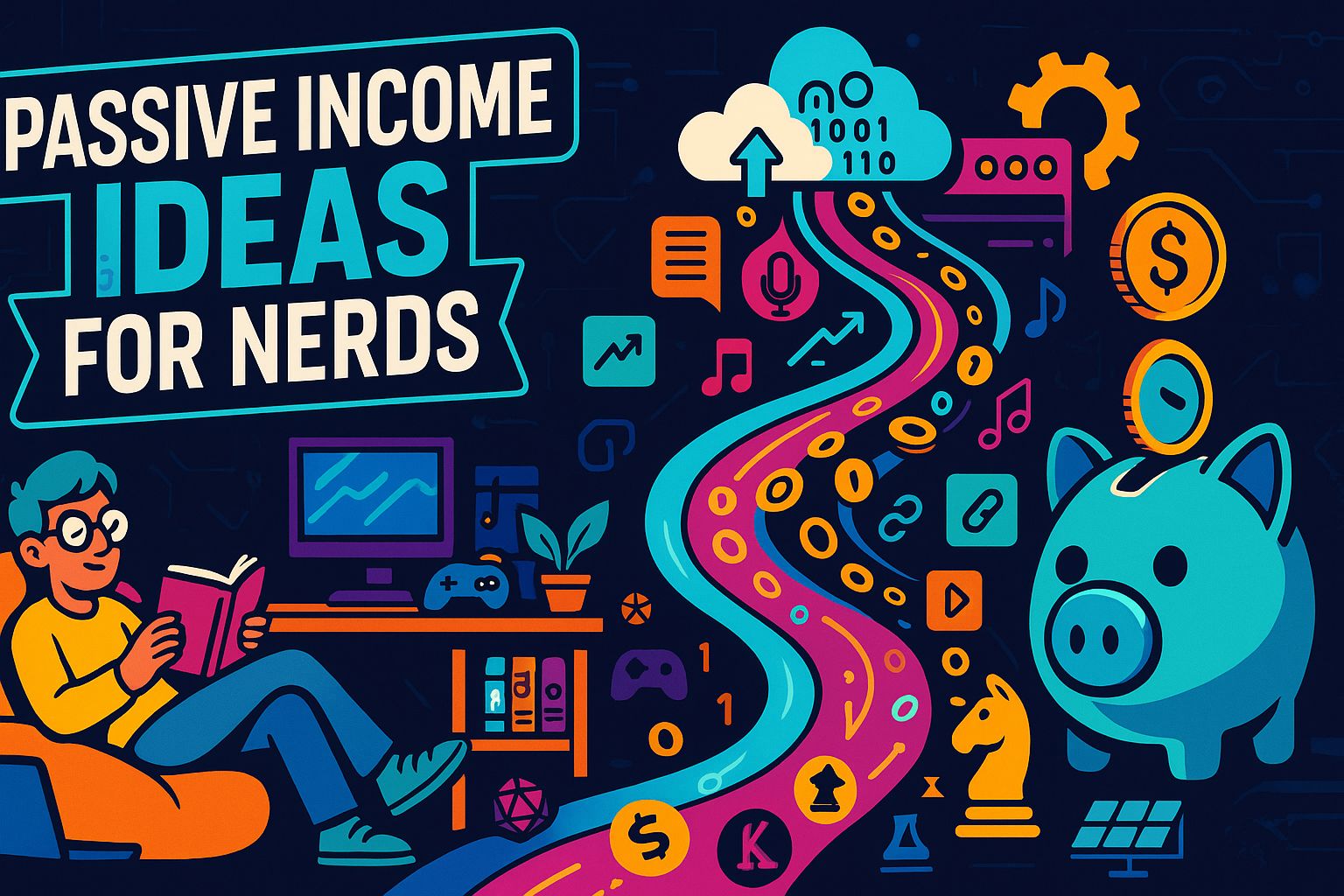Ever wish your money could work as hard as you do when you’re deep in a coding session or finally beating that last boss?
Lots of people are turning to passive income to build up their cash flow without adding a ton of extra stress. For us geeks, this doesn’t have to mean complicated things like managing rental properties.
We’re talking about clever ways to make your interests in tech, data, and digital content pay you back.
I’m going to walk you through 15 geek-friendly passive income ideas, from smart investing to launching your own digital products. Let’s dive in and find a method that works for you.
Key Takeaways
Investing in dividend stocks and index funds through platforms like Fidelity or M1 Finance can create a steady income stream. For example, some REITs can offer high yields, but all investments carry risk. It’s a legal requirement that REITs pay out 90% of their taxable income as dividends.
Peer-to-peer lending on a site like Prosper lets you invest in personal loans, but it comes with risks. A historic court decision in 2024 affirmed that platforms like Prosper are not considered banks, which clarifies their regulatory standing for investors.
Creating content like a blog or YouTube channel can start small but grow into a significant online business. Reaching YouTube’s first monetization tier requires 500 subscribers and 3,000 watch hours. Top creators can earn millions, showing the high potential of this path.
If you can code, you can build a Software as a Service (SaaS) product or browser extension for recurring revenue. Indie developer Pieter Levels famously built multiple small projects, including Nomad List and PhotoAI, earning millions from his one-person businesses.
Renting out your assets, like a spare room on Airbnb or a parking spot on a service like Neighbor.com, can turn unused property into a reliable source of rental income.
Table of Contents
Investments for Passive Income

Investing is one of the most classic ways to generate passive income. For geeks who love data and systems, options like dividend stocks, index funds, and real estate investment trusts (REITs) are a natural fit.
You can analyze trends, build automated investment plans, and watch your money grow without getting your hands dirty.
How can I invest in dividend stocks or index funds for steady income?
Think of investing in dividend stocks and index funds as setting up a script that deposits money into your account while you’re busy with other projects. It all starts with a brokerage account and a solid plan.
You can get started with platforms like Fidelity, which is known for its robust research tools, or M1 Finance, which is popular for its “Pie” based automated investing that’s great for dividend portfolios.
Here are a few key steps to get going:
- Pick a Platform: Set up an account with a broker like Fidelity for broad features or M1 Finance if you want to automate your dividend reinvestment across your entire portfolio, not just back into the stock that paid it.
- Fund Your Account: You don’t need a massive amount to start. Many people begin with a few hundred dollars and add to it over time.
- Find Quality Stocks: Look for “Dividend Aristocrats,” which are S&P 500 companies that have increased their dividends for 25 consecutive years. This history suggests stability.
- Use a DRIP: A Dividend Reinvestment Plan automatically uses your dividend payouts to buy more shares, compounding your growth much like optimizing code for better performance.
- Check the Payout Ratio: A company’s payout ratio tells you what percentage of its earnings are paid out as dividends. If it’s too high (over 80% for many industries), it could be a warning sign that the dividend is unsustainable.
I bought my first dividend ETF during college finals week and saw the first small payout hit my account while I was playing Zelda. That feeling of earning money while doing something I love was what got me hooked on passive investing.
What is REIT investing and how does it generate income?
If you like the idea of earning rental income but don’t want the hassle of being a landlord, Real Estate Investment Trusts (REITs) are a fantastic option. You’re essentially buying shares in a company that owns and manages a portfolio of properties.
By law, REITs must pay out at least 90% of their taxable income to shareholders as dividends. This regulation is what makes them such a popular choice for income-focused investors.
You can buy and sell REITs through any standard brokerage account, just like stocks. They offer a simple way to get into real estate, from office buildings and shopping centers to apartment complexes.
For example, Realty Income Corp (ticker: O) is a well-known REIT that calls itself “The Monthly Dividend Company” and has a history of reliable payouts. As of late 2024, the average dividend yield for all U.S. equity REITs was around 3.88%.
This means a $10,000 investment could generate around $388 per year in passive income, without you ever having to fix a leaky toilet.
A friend of mine in Houston prefers the hands-on approach and uses an apartment property management company to handle his rentals, but for most geeks, REITs offer the perfect blend of real estate profits and hands-off investing.
How do peer-to-peer lending platforms work for passive earnings?
Peer-to-peer (P2P) lending used to be a popular way for geeks to play banker, connecting investors directly with borrowers through online platforms. However, the landscape has changed significantly.
Lending Club, one of the biggest pioneers, shut down its retail investor platform back in 2020 after acquiring a bank. This move marked a major shift in the industry, moving away from individual investors.
Today, Prosper is one of the few remaining major platforms in the U.S. that still allows individual investors to participate. It works by letting you fund portions of personal loans and earn interest as borrowers pay them back.
Here’s how it typically works on a platform like Prosper:
- Browse Listings: The platform uses algorithms to assess borrower risk and assign a grade to each loan. You can see details like their credit score and reason for borrowing.
- Diversify Your Investment: You can invest small amounts across many different loans (sometimes as little as $25 per loan) to spread out your risk.
- Earn Interest: As borrowers make their monthly payments, you receive a proportional share of the principal and interest.
The returns can be attractive, but so are the risks. Default rates can be much higher than with other investments, and your money isn’t federally insured like it is in a savings account. It’s an interesting option for those who love data and risk analysis, but it’s wise to start small.
What are crypto staking and running nodes for income?
For the more tech-adventurous geek, crypto staking is like earning interest on your digital assets. By “locking up” your cryptocurrency, you help secure the network and get rewarded with more coins in return.
It’s based on a system called Proof-of-Stake (PoS), which is far more energy-efficient than the Proof-of-Work (PoW) model used by Bitcoin.
You have a few ways to get involved:
- Staking on an Exchange: Platforms like Coinbase or Kraken make it incredibly simple. You just choose which crypto to stake and they handle the technical side for a small fee.
- Liquid Staking: Services like Lido Finance let you stake your crypto (like Ethereum) while still receiving a tradable token (stETH) in return. This gives you the flexibility to use your assets in other DeFi applications while still earning rewards.
- Running a Node: This is the most hands-on approach. It involves running your own server to validate transactions on a blockchain. While it offers higher rewards, it also requires significant technical knowledge and a substantial initial investment.
The rewards can vary widely. For example, as of October 2025, staking Ethereum (ETH) could yield an APY between 4-6%, while other coins like Solana (SOL) might offer 2-7%. It’s a fascinating way to make your assets work for you, but be mindful of the high volatility and security risks involved.
Content Creation and Digital Products

If you have a passion for a specific nerdy topic, you can turn that knowledge into a stream of passive income. Creating content or digital products takes upfront work, but once they’re out there, they can earn money for you 24/7.
How can I start a blog or YouTube channel for passive income?
A blog or YouTube channel is a fantastic way to share your passions, whether it’s coding tutorials, video game lore, or gadget reviews. Over time, these platforms can become powerful income generators.
https://www.youtube.com/watch?v=D9eLzDa-_8Q
The key is consistency and focusing on a niche you genuinely love. You’ll monetize your content primarily through a few methods:
- Ad Revenue: Once you meet certain requirements, you can place ads on your content. For YouTube, the first tier of the Partner Program opens up at 500 subscribers and 3,000 watch hours (or 3 million Shorts views). Full ad revenue sharing unlocks at 1,000 subscribers and 4,000 watch hours.
- Affiliate Marketing: You can include special links to products you recommend. When someone buys through your link, you get a commission. Amazon Associates is a popular starting point for tech and gadget reviews.
- Sponsored Content: As your audience grows, brands may pay you to feature their products. According to a 2024 report, even small creators with 1,000 to 10,000 followers can earn between $50 and $300 per promotional post.
Don’t expect overnight success. It took me four months of blogging to earn my first dollar from an affiliate link. But if you stick with it and use SEO tools like Ahrefs or Google Keyword Planner to find topics people are searching for, you can build a real audience and a steady income stream.
What are the best ways to create and sell online courses?
If you have a skill that others want to learn, creating an online course is an excellent way to package your knowledge. Geeks with expertise in areas like Python, data science, or even advanced Excel formulas are in high demand.
You can host your course on a few different types of platforms:
- Marketplaces: Sites like Udemy and Skillshare have a built-in audience of millions of learners. They handle the marketing for you but take a significant cut of the revenue. The average Udemy instructor earns around $3,306 per year, but top earners make much more.
- Self-Hosted Platforms: Platforms like Teachable or Kajabi give you full control over your branding, pricing, and student data. You keep a much larger portion of the revenue, but you’re responsible for driving all your own traffic.
A great way to get started is by creating a short, free mini-course to build an email list. This lets you validate your topic and build an audience before you invest time in creating a full premium course.
How do I develop and sell eBooks effectively?
Selling eBooks is another great way to monetize your expertise without the complexity of video production. You can write about anything from a technical manual for a programming language to a strategy guide for a popular video game.
Here’s a simple path to getting your eBook out there:
- Write and Format: Focus on solving a specific problem for your reader. Use tools like Grammarly to polish your writing and a program like Calibre to format your book for different e-readers (MOBI for Kindle, EPUB for others).
- Choose a Platform: You can self-publish on Amazon Kindle Direct Publishing (KDP) to reach the world’s largest bookstore. Alternatively, platforms like Gumroad or Payhip are excellent for selling directly to your audience, especially for PDF guides and tutorials.
- Promote Your Book: Share your eBook with relevant online communities, like Reddit subreddits or Discord servers dedicated to your topic. Writing blog posts related to your book’s content is also a powerful SEO strategy to attract buyers.
How can I offer digital templates, scripts, or design assets for profit?
If you’re skilled in design or coding, you can create digital assets that others can buy and use. This is a perfect fit for geeks who love building things but may not want to be in the spotlight.
The possibilities are endless:
- Notion & Excel Templates: Productivity nerds love well-designed templates. You can create budget trackers, project management dashboards, or content calendars and sell them on platforms like Etsy or Gumroad.
- Code Snippets & Scripts: If you’ve written a useful Python script for web scraping or a JavaScript function for a cool animation, you can sell it on a marketplace like CodeCanyon.
- Design Assets: Graphic designers can sell custom icon packs, PowerPoint themes, or Illustrator brushes on sites like Creative Market. These platforms handle the payment processing and delivery, and they typically offer commissions ranging from 50-70%.
A great strategy is to offer a few free assets to build an email list. Once you have an engaged audience, you can promote your premium products directly to them.
Software Development and Tools

For those who can code, the ultimate passive income dream is to build a digital tool that works for you. Whether it’s a full-blown SaaS application or a simple browser extension, software can be a powerful engine for recurring revenue.
How do I build a SaaS product for recurring revenue?
Software as a Service (SaaS) is the holy grail for many developer-nerds. You build a product once, and customers pay a recurring subscription fee to use it. I launched a small SaaS product in 2023, and the journey taught me that finding the right problem is half the battle.
The key is to start small by building a Minimum Viable Product (MVP). Don’t try to build the next Mailchimp, which grew to $700 million in annual recurring revenue before being sold. Instead, follow the “indie hacker” path like Pieter Levels, who created successful one-person businesses like Nomad List by solving a very specific problem for a niche audience.
Here are some key steps:
- Find a Niche Problem: Hang out in forums or Reddit communities related to your interests. What tedious tasks do people complain about that could be automated?
- Build an MVP: Create the simplest possible version of your solution. Your goal is to validate that people will pay for it before you spend months adding features.
- Use a Payment Processor: Services like Stripe or Paddle make it incredibly easy to handle subscriptions and billing.
- Offer a Freemium Model: A free trial or a limited free plan, like the one used by Slack and Trello, is a great way to let users experience the value of your product before they commit to paying.
What are the steps to develop and sell browser extensions or apps?
If a full SaaS product seems too daunting, a browser extension or a simple mobile app can be a fantastic starting point. You can solve a small, specific problem and generate passive income through a one-time purchase, a subscription, or even affiliate links.
Many successful extensions operate on a “freemium” model. For example, Grammarly offers core spell-checking for free but charges for advanced features like tone detection. This approach allows you to build a large user base that you can later upsell to.
When you’re ready to publish, you can use these major platforms:
- Chrome Web Store
- Apple App Store
- Google Play Store
A word of caution: make sure you have a crystal-clear privacy policy. Both Google and Apple are strict about how user data is handled, and a vague policy is a common reason for an app to be rejected during the review process. And if you’re looking for more inspiration, there are many other tech side hustles to explore.
How can I create and monetize website themes or plugins?
With WordPress powering over 40% of the entire internet, there is a massive and constant demand for new themes and plugins. If you have web development skills, this is a market you can tap into for steady sales.
You can solve common problems for website owners, like creating a plugin for a specific SEO task or designing a theme for a niche industry like photographers or restaurants.
You have two main paths for selling your creations:
- Marketplaces: Sites like ThemeForest and Mojo Marketplace give you access to a huge global audience. They handle all the marketing and sales, but they take a commission on each sale. The average price for a premium theme on ThemeForest can range from $39 to $79.
- Direct Sales: You can sell themes and plugins directly from your own website. This gives you full control over your pricing and you keep all the revenue, but you’re responsible for driving your own traffic. A great example of this model is Elegant Themes, the company behind the popular Divi theme.
No matter which path you choose, providing excellent customer support is key to getting good reviews and building a solid reputation.
How do I build and sell automation scripts or bots?
For the true automation geek, building and selling scripts or bots can be a fun and profitable venture. You can create tools that automate tasks in social media, data scraping, or even crypto trading.
Python is a popular language for these types of projects due to its powerful libraries for web scraping (like BeautifulSoup) and data analysis. Once you’ve built a useful script, you can sell it on platforms like CodeCanyon or directly to your audience through Gumroad.
A crucial piece of advice is to be very careful about the terms of service of the platforms you’re automating. Building a bot that violates the rules of a site like Instagram or Twitter is a quick way to get your users’ accounts banned and destroy your product’s reputation.
Always build your bots ethically and provide clear documentation so your users know exactly what they’re running.
Unique Passive Income Opportunities

Thinking outside the box can lead to some surprisingly effective passive income streams. For geeks, this means applying a data-driven or system-based approach to less obvious opportunities.
How can I rent out a parking space, car, or spare room?
You can turn your underutilized assets into cash-generating machines with the help of a few apps. This is the classic “sharing economy” model, and it’s perfect for generating passive income with minimal ongoing effort.
- Spare Room: Listing a room on Airbnb can be very profitable. In 2022, the average U.S. host earned about $14,000. It requires some initial setup, but once you have a system for cleaning and check-ins, it can become quite passive.
- Parking Space: If you have an empty driveway or parking spot in a busy area, apps like Spacer or Neighbor.com let you rent it out. This is especially lucrative near downtown areas, stadiums, or university campuses.
- Your Car: When you’re not using your car, you can list it on Turo. It’s like Airbnb for cars. Your earnings will depend on your car’s model and your location, but it’s a great way to offset the costs of car ownership.
The key to success with these platforms is to think like a data analyst. Take high-quality photos, write detailed descriptions, and research your local market to price your asset competitively.
What is the best way to sell high-quality stock photos?
If you have a good eye and a decent camera (even a modern smartphone), you can sell your photos on stock photography websites. Each time someone downloads your image, you earn a royalty. It’s a numbers game, the more high-quality photos you have in your portfolio, the more you’ll earn.
Here’s how the commissions typically break down on major platforms:
| Platform | Typical Commission Rate for Photos |
|---|---|
| Adobe Stock | 33% |
| Shutterstock | 15% – 40% (based on lifetime earnings) |
| Alamy | Up to 50% |
| iStock (by Getty Images) | 15% – 45% |
The secret is to focus on a niche. Instead of generic landscapes, shoot photos of specific tech setups, coding on a laptop, or people interacting with gadgets. Use strong, descriptive keywords to make your photos discoverable, just like you would for SEO on a blog post.
How do I promote products through affiliate marketing?
Affiliate marketing is the art of earning a commission by promoting other people’s products. For geeks, this is a natural fit for a blog, YouTube channel, or even just a personal website where you review products you use and love.
The global affiliate marketing industry is massive, valued at over $18.5 billion and projected to grow significantly by 2031. This shows just how powerful this income stream can be.
Here’s how to do it right:
- Choose a Niche: Stick to what you know. If you’re into home automation, review smart home gadgets. If you’re a developer, recommend hosting services or software tools.
- Join the Right Programs: Amazon Associates is a great starting point, but don’t stop there. Look for direct affiliate programs from companies you admire. Networks like ShareASale and Impact Radius also connect you with thousands of brands.
- Be Authentic: Only recommend products you truly believe in. Your audience’s trust is your most valuable asset. Write detailed, honest reviews that help people make an informed decision.
- Disclose Your Links: It’s not just good practice, it’s the law. The FTC requires you to clearly disclose that you may earn a commission from your affiliate links.
How Will Passive Income Opportunities Evolve in 2025?
Looking ahead, tech will continue to create new and exciting passive income streams, especially for nerds.
AI-driven platforms are set to simplify complex areas like crypto investing. For instance, services like Invro Mining are emerging that use machine learning to manage cloud mining, allowing users to participate with as little as $100 without needing deep technical knowledge.
The creator economy is also booming. Influencer marketing is projected to become a $32.55 billion industry in 2025, showing a huge shift towards individuals monetizing their content and communities. This means more tools and platforms will appear to help creators sell digital products, manage memberships, and earn through affiliate sales.
Even traditional investments like REITs and index funds are becoming more accessible through apps that automate investing and offer fractional shares.
The core idea remains the same: use your unique skills and interests to build systems that generate income. Whether you’re coding an app, analyzing market data, or sharing your knowledge with the world, the opportunities for geeks to build wealth passively have never been better.
People Also Ask
How can I earn passive income with affiliate marketing if I love tech and games?
You can start a YouTube channel reviewing gadgets and join affiliate programs from brands like Razer or Logitech, which offer commissions up to 10% per sale. By placing their links in your video descriptions, you earn money whenever someone buys through them.
Are high-yield savings accounts or money market funds better for nerds looking for safe passive income?
Both are great low-risk options, but high-yield savings accounts are FDIC-insured up to $250,000, which guarantees your principal. Money market funds aren’t FDIC-insured but are still considered very safe and sometimes offer slightly higher returns, with top accounts for both hovering around 4% APY.
Can I use my knowledge of SEO and digital marketing for passive income?
Yes, by creating a niche website, you can monetize traffic through ad networks like Google AdSense or through affiliate marketing partnerships.
What are some geeky ways to invest for passive income besides stocks?
You can try peer-to-peer lending on platforms like LendingClub, or invest in real estate through REITs, which are companies that own income-generating properties. Another option is purchasing U.S. Treasury securities directly from the government, which are considered very safe investments.
Is creating online courses a good passive income idea for nerds?
It’s an excellent idea; you can package your expertise on a specific topic and sell it on platforms like Udemy or Skillshare. Once your course is created, it can generate income for years with minimal additional effort.
References
https://www.nerdwallet.com/article/investing/how-to-invest-dividend-stocks
https://www.youtube.com/watch?v=8O0-vMWgeKs
https://www.nerdwallet.com/h/category/real-estate-alternative-investments
https://www.investopedia.com/terms/p/peer-to-peer-lending.asp
https://money.com/staking-101-how-locking-crypto-generates-passive-income/ (2025-08-13)
https://www.nerdwallet.com/article/investing/what-is-passive-income-and-how-do-i-earn-it (2025-09-15)
https://www.nerdwallet.com/article/finance/how-to-make-money (2025-08-19)
https://speckygeek.com/passive-residual-income-online/
https://angrynerds.co/blog/guide-how-to-build-a-saas-product-in-2023/ (2023-04-28)
https://angrynerds.co/blog/how-to-build-a-saas-product-beginners-guide/ (2022-04-29)
https://www.greengeeks.com/blog/15-types-of-websites-make-money/
https://medium.com/geekculture/7-passive-income-ideas-for-programmers-86c398a8cd81
https://www.greengeeks.com/blog/earning-ai-tips-tools-methods-examples/
https://nerdbot.com/2025/09/15/7-ways-geeks-can-earn-passive-crypto-income-in-2025-no-trading-or-nfts-required/ (2025-09-15)
